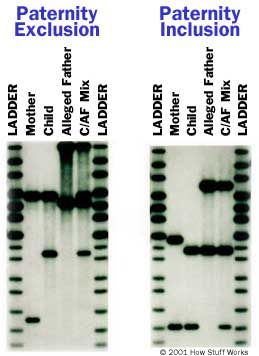Using DNA Evidence Beyond the Courtroom
DNA evidence plays a pivotal role in the modern criminal justice system, but the same techniques that prove guilt or exonerate an innocent person are just as useful outside the courtroom. Here are a few examples:
- Paternity testing and other cases where authorities need to prove whether individuals are related or not -- One of the more infamous paternity cases of late occurred after Anna Nicole Smith's death in 2007. Five different men claimed to be the father of Smith's baby daughter, Dannielynn. After a DNA test, Larry Birkhead was proven to be the child's father.
- Identification of John or Jane Does -- Police investigators often face the unpleasant task of trying to identify a body or skeletal remains. DNA is a fairly resilient molecule, and samples can be easily extracted from hair or bone tissue. Once a DNA profile has been created, it can be compared to samples from families of missing persons to see if a match can be made. The military even uses DNA profiles in place of the old-school dog tag. Each new recruit must provide blood and saliva samples, and the stored samples can subsequently be used as a positive ID for soldiers killed in the line of duty. Even without a DNA match to identify a body conclusively, a profile is useful because it can provide important clues about the victim, such as his or her sex and race.
- Studying the evolution of human populations -- Scientists are trying to use samples extracted from skeletons and from living people around the world to show how early human populations might have migrated across the globe and diversified into so many different races. In the 1980s, scientists at the University of California, Berkeley, used mitochondrial DNA analysis to speculate that all living humans are related to a single woman -- "Eve" -- who lived roughly 150,000 years ago in Africa. Other scientists, using increasingly more sensitive DNA analysis, have since confirmed this to be true.
- Studying inherited disorders -- Scientist also study the DNA fingerprints of families with members who have inherited diseases like Alzheimer's disease to try to ferret out chromosomal differences between those without the disease and those who have it, in the hope that these changes might be linked to getting the disease. DNA testing can also reveal a person's susceptibility to certain diseases. Several companies, such as 23andMe, deCODEme and Navigenics, offer at-home genetics tests that can evaluate your risk for hundreds of diseases and traits, including breast cancer, rheumatoid arthritis and Type 2 Diabetes.
- Catching poachers -- Wildlife biologists are now turning to DNA tests to catch people who hunt illegally. For example, the hunting season for doe on public lands lasts only two days in many states. If a wildlife official suspects a hunter has shot a female deer after the official close of the season, he can analyze DNA from the meat and determine the species and gender of the animal.
- Clarifying history -- Historians are turning to DNA evidence to learn more about the past. For example, Y-chromosome testing was used in 1998 to determine whether Thomas Jefferson, the third president of the United States, fathered children with one of his slaves or not. And in May 2009, a group of historians asked a Philadelphia museum if they could have access to a strip of a pillowcase stained with the blood of Abraham Lincoln. Their goal was to analyze Lincoln's DNA to see if he suffered from a rare genetic cancer syndrome called multiple endocrine neoplasia type 2B, but the museum's board would not allow the test at the time.
Advertisement
